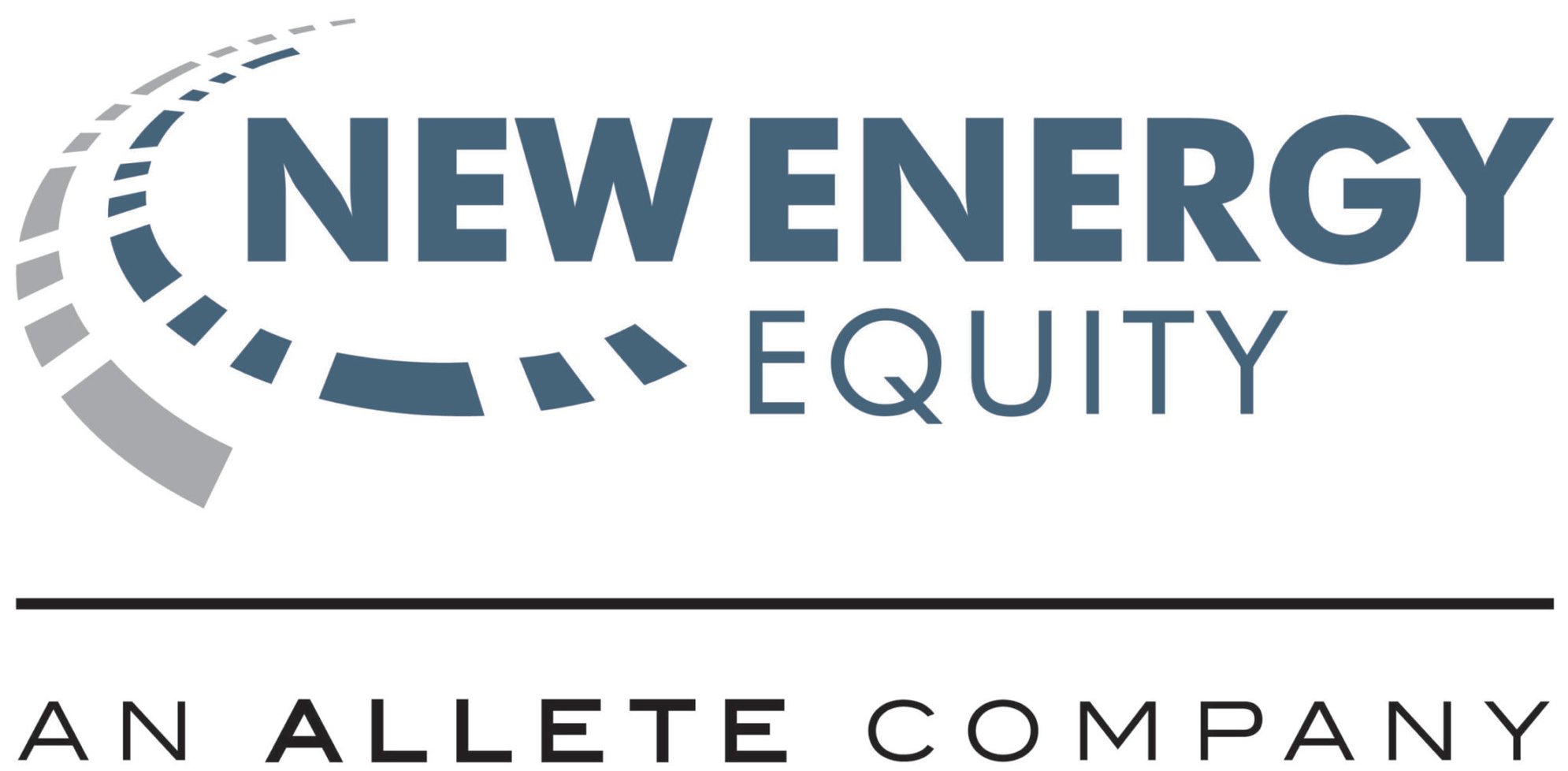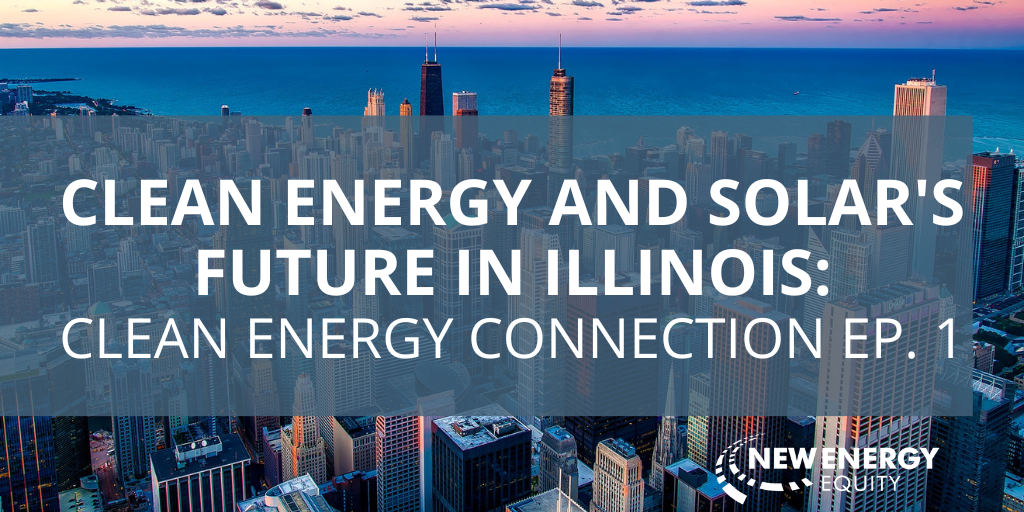New Energy Insights
- Home /
- New Energy Insights /
- Clean Energy and Solar's Future In Illinois: Clean Energy Connection EP. 1
(Interview starts at 1:08:00)
Proponents of Clean Energy: About the Guests

Lesley McCain, Executive Director, ISEA
Prior to accepting the position as Executive Director of the Illinois Solar Energy Association, McCain served on the ISEA board from September 2009 until April 2012. As a board member she was Chair of Marketing Committee. Lesleypreviously worked for Community Energy Inc.(CEI) as the Midwest Director of Business Development. She started with CEI in 2005 as the Residential Program Manager for the award winning City of Naperville Renewable Energy Program, and in 2006 added corporate and industrial sales to her responsibilities. McCain also serves on the board of the Illinois Environmental Council. She is grateful to have the opportunity to use her personal energy to help with the transition to the clean energy economy.

Eric Pasi, Chief Development Officer, IPS
As Chief Development Officer for Impact Power Solutions, Pasi has helped organizations analyze and adopt clean energy strategies nationwide. He is extremely passionate about renewable power, entrepreneurship and the climate crisis. In 2020, he released his first book called “CleanWave: A Guide to Success in the Green Recovery” where he outlines the past, present, and future of clean tech, and its role in a post-COVID19 and post-George Floyd recovery.
Interview Transcript
Joan E: This segment of Joan Esposito live local and progressive is sponsored by Impact Power Solutions. A company that knows clean energy in Illinois and throughout the Midwest. Eric Pasi is the chief development officer. And he joins us now. And Eric, is Lesley with us as well?
Okay, and Lesley McCain from ISEA is here. Good to know that you guys are both here. Welcome to WCPT and thank you for being a part of our station and our broadcast.
Eric P: Joan, good afternoon, I'm so excited!
Joan E: One of the things that I really wanted to talk to you about is Joe Biden's plan for clean energy and to get more wind power and more solar power. And explain to our listeners exactly what your company does, what Impact Power Solutions does.
Eric P: Yeah, absolutely. And thanks again for having us. Impact Power Solutions, we're a solar development company based in the Midwest, and we specialize in commercial and community scale solar solutions. You're correct, right now is a very interesting and exciting time related to clean energy. And we're very excited to talk with your listenership about everything that's happening both at a federal and a state level related to renewable energy. And actually, today, we have Lesley McCain, who is the Executive Director for the Illinois Solar Energy Association that's also joining us.
Joan E: My knowledge of this subject as listeners who are regular listeners to this show know, when I've talked about things like solar and how all the energy grid works, the depth of my ignorance is staggering. Eric and Lesley, so this is going to be informative for me as well as the audience. So I was just trying to look through the press release for the COVID relief bill because I know they've been trying to expand it to other areas. Clearly, Joe Biden is going to tackle clean energy separately. What have you gleaned from the things Joe Biden has said about what we can expect, as far as support for clean energy from Washington.
Eric P: Yeah, absolutely. So on a federal level, we know that this is part of the Biden and Harris administration's four pillars, addressing climate along with equity, economic recovery, and the COVID situation as well. And so we didn't get much out of the most recent relief package, but we are looking toward infrastructure and climate kind of being the next piece of the puzzle here that the administration wants to address.
Joan E: What do you think the timetable is going to be for this?
Eric P: It's a great question. We have, obviously, our own lobby group here and I can let Lesley hop in here if she's got any insight that she's hearing from the national level.
Lesley M: Great. Thanks, Eric. Thanks so much again, Joan, for giving us this opportunity. You admitting your sometimes confusion on what happens with energy is, you know, it's a pretty broad thing out there in the general public. So this is great to have the opportunity to build it to help people understand what is happening broadly with energy development and clean energy development, specifically to Illinois. So we're focused a lot on state policy, which we'd like to touch base on today. But honestly, there's a lot of excitement. What is happening at the federal level? It really has been the states leading the charge on clean energy development for at least the last couple of decades, perhaps. You know, as far back as clean energy has been done, there hasn’t been a whole lot of support from the federal government. So to see climate become a cabinet position, and understand as Eric said that both climate and infrastructure are very high on the Biden administration's list of priorities, which gives us all a lot of hope. Because we do know that clean energy is the significant solution for climate change concerns. I have heard that now that we've passed this significant stimulus package, that the administration feels that they have momentum, and will pick up another significant lift very, very soon. So I'm hoping that we'll see that activity related to clean energy development in one of those two packages this spring.
Joan E: Aside from what we can expect from the national level, Lesley, since your focus is the state of Illinois, what is what's going on here? Are there any bills that we should keep an eye on down in Springfield?
Lesley M: Yes, there are. Thank you for asking. So just a little bit of a little bit of background, at the end of 2016, Illinois passed a significant piece of legislation to help develop wind and solar here in the state called the Future Energy Jobs Act and that gave us a goal of reaching 25% clean energy for the state by the year 2025. That piece of legislation, which we thought was so significant at the time, just did not give us enough of a runway for all of the pent up demand here in the state. So unfortunately, we have run out of money for that budget for additional clean energy development, here in Illinois. And so yes, we are hoping that maybe your listeners will help put their shoulder to the wheel and send letters to their legislators to help pass that piece of legislation that we're currently working on that will fix this budget called The Path To 100, as governor Pritzker has committed to 100% clean energy here in Illinois. So we're very excited about that. But we do need a path to get to that goal and we don't have that currently. So if folks want to visit the Illinois Solar Energy Association website, which is just Illinoissolar.org. At the top of the page, you'll see a link to find the path to 100 letter that would go to your local legislators and just encourage them to continue to pay attention to clean energy development here in the state. We do have broad support with the General Assembly in Springfield, as well as at the governor's office. So I'm very hopeful that we will see a repair to this budget this spring, because the waiting lists from homeowners, small businesses, community solar developers and the like, are growing. They're very long waiting lists of people waiting to get solar developed, but we just need the incentive to be able to flow here in the state. Once again, I want to mention that we have developed quite a bit of clean energy in the last couple of years since the passage of that Future Energy Jobs Act. Illinois has added 309 megawatts of small scale solar, actually, that happened last year. And that's the third highest number of additions across the country, according to the Energy Information Administration, and Illinois currently enjoys 515 megawatts of clean energy. That covers the energy needs for over 100,000 homes. So you can see that people are very excited about being powered by solar here.
Joan E: Lesley and Eric, we’re going to take a quick break. And when we come back, Eric, there's a couple of things I want to talk to you about and that's solar panels and things like that for home use and what the economics of that situation is. And also you may have heard that the governor of Texas blamed the whole grid crash on windmills, those darn windmills, they got all icy and the whole state went to heck in a handbasket. So I'm gonna ask you to weigh in on that. We're talking to Eric Pasi and Lesley McCain about clean energy we're going to continue this discussion after a break.
Joan E: Right before we went to break, I reminded Eric, that Governor Abbott of Texas, I believe it was the governor, but certainly, some lawmaker in Texas blamed the recent grid crash there on the fact that those darn windmills froze up. And there you go. And isn't clean energy a bad thing? And I don't know if anybody pointed out to him that there are lots of really cold countries in the world that use those same windmills. And you know, what, they use them year round, and they never have any problems. What would you say to the people in Texas, Eric?
Eric P: Yeah, isn't that strange? I mean, we've seen windmills work across the Midwest with no issue. And really, it comes down to a concept or methodology of how you run the electric grid in your local area. We've had several weeks to digest this. Texas is, as everybody knows, big on self-reliance and kind of a go it alone strategy. And that just doesn't work that well when it comes to the electric grid, which spans nationwide. Texas is governed by a local grid called the ERCOT. For years they've really tried to withstand any input from the Federal Energy Regulatory Commission to help with this issue, which is what happens when local grids have had problems, and need to port in electricity from elsewhere. You know, when we leave decisions to the free market with little to no oversight, the free market will take the least costly approach. This is what happened exactly as it pertains to weatherization. What happened in the Texas grid is really a story that has gone back for decades. This wasn't the first disaster in Texas related to cold weather. 1989, 2011 most recently, we had similar crises. And at the end of that most recent one in 2011, an exhaustive study was released, and it urged regulators to require upgrades to weatherize the grid and specifically natural gas facilities, which had pipes freeze & burst in this most recent disaster, which caused outages across the state. We saw some homeowners receive monthly electricity bills of over $10,000, the cost of electricity spiked to 3,000%. And even our own Chicago-based Exelon is expecting a half billion dollar hit in the first quarter because of this issue. And really, what we need to think about is, how do we plan for the worst, knowing that our climate is changing? And that's going to be the number one point on many people's letter to the governor asking for, for some reform here after this disaster.
Joan E: I thought it was interesting, Eric. I read that there was one area around El Paso, where the grid did not go down and the utility company there, even though as you just pointed out, much of the state of Texas resisted any kind of federal regulation. They left it up to the utility companies, even though they had a devastating snowstorm 10 years ago that did much the same damage. They left it up to the utility companies. And one power company in El Paso, Texas, decided to go ahead and spend the money and winterize their equipment, I think their equipment was good to 10 below zero. And you know what, Eric? They didn't lose power. And that was a story that I thought needed to get a lot more attention. Everybody was like, oh, everybody in Texas is suffering. Well, everybody except this one area that decided that even without the state breathing down their neck and even without federal necessity that they would do the responsible thing. The other thing I wanted to talk to you about Eric, is from time to time since I've started doing this show, I talked to people about solar. You know, I know that solar farms exist and they can be great even in the Midwest with our weird weather for generating power. But what about solar for your home? Does that make sense? Or does it only make sense if you're going to live in your house, you know, five or 10 or 15 years to amortize the costs?
Eric P: Great question. And, Joan, I want to just touch on what you'd mentioned about El Paso in terms of the weird geographic issues that plagued the Texas grid. Actually, El Paso is part of a different separate grid, mid intercontinental system operator MISO, so they actually avoided the issues from ERCOT. So back to your question about solar, for residences. I've been with Impact Power Solutions since 2007, right out of college. I started as a residential installation expert and then moved into sales and other areas of the company since that time. it's really moved from just people with means and ideals to really mainstream at this point. For most residences that are looking to install solar, you're going to see somewhere between an eight to a 10-year return on investment. Not just that, it adds to the equity of your home. So when you mentioned, if you're going to stay in your home for five to 10 years, well, actually if you're going to incorporate the equity value of the system upon resale, that payback is even less than two years, in most cases. It's a really fantastic investment for homeowners. You know, some of the challenges that we've seen, though, is that there's kind of a Goldilocks situation. You’re looking for a newer roof that you want to install the system on, you're looking for the roof to be unshaded and oriented somewhat close to South. In cases where maybe you're renting your home, maybe you're in an apartment or a condo, and you don't have access to actually put solar on your roof, or you don't want to put it on your roof. Really what Illinois and a lot of other states have done is allow folks to participate in programs, like community solar. That's what has been a major driver in the state. The concept behind that is homeowners and residents and businesses and schools can participate in solar by subscribing to a solar field that's located off site, not on their home, and not necessarily next to their business. What happens is that the utility will monitor the production and then provide bill credits on your bill. Then you're usually working with a solar provider then to pay back a portion of those savings. It's a really neat and, and very lucrative solution for the residents that are expecting to save money from day one without having to put any capital up to participate. So that's a kind of new wrinkle for folks that can't put it on their home or don't want to. You've got community solar as an option as well.
Joan E: Okay, Eric, we started this discussion with my reminder of my utter and complete ignorance on this topic. So what you just talked about when you said “homes or schools could subscribe”. What does that mean? Does that mean I as a homeowner find a solar farm somewhere, and I just sign up like a book club? I pay them a monthly fee? I'm a little confused here.
Eric P: Yeah, it's almost as simple as signing up for a book club. I would encourage folks to go to The Illinois Solar Energy Association website. Lesley's organization has a list of providers for community solar, and also more information about how it works. So if folks did not catch that at the outset, Illinois, solar.org is the website you can check out how community solar works, see if it's a good option for you. And it's available statewide.
Joan E: Lesley, I used to get a newsletter that was all about clean energy and solar energy. They had all these articles of futuristic stuff or stuff that was being tested in labs right now. And there were articles about maybe like blinds in your house, maybe the blinds could have little solar coatings and the blinds that you have on your windows could generate some energy. There was even an article that I read, and I don't understand how this could possibly work, but they were talking about paint, how you can paint your wall and somehow the paint itself would be constructed in a way to produce energy. Are any of these ideas close to fruition? I would buy solar blinds. That's a good thing.
Lesley M: I’ve seen some of those articles myself in the past. I don't know if they have been turned into reality. I don't know if Eric does. I do know there's an organization here in the Midwest, they're out of Iowa (don't quote me on that) called Solar Roadways. They are working on embedding solar into driveways, and streets and sidewalks. There is all that type of innovation happening. I don't know if there's any solar blinds available. I've not heard that, no. But you know, we have seen walls made of solar, we've seen shingles, folks are paying attention to Tesla. So, this building integrated concept of integrating solar into everyday material, it's definitely coming.
Joan E: That's so very cool. What else do you guys want our listeners to know? Eric, you have the floor. Tell our listeners what they need to know about Impact Power Solutions. Then we'll give the last word to Lesley.
Eric P: Absolutely. So again, thanks everybody. One thing that I think your listeners might be interested in, because solar is a hot topic, both for job creation and for folks that might be either mid-career or coming out of school. I recently wrote a book, it's called Clean Wave: A Guide to Success in the Green Recovery and it's really focused on the past, present and future of clean technology, with actionable advice for career seekers. The website is www.cleanwavebook.com if folks want to go and see how this transition could benefit them from a career standpoint. We need talent, and we're looking for talent so I would encourage folks to go check that out. In fact, Impact Power Solutions is hiring across the country. I encourage folks to go check us out at www.ips-solar.com where we mainly focus on commercial scale and community scale solar projects. And again, Joan, really appreciate you having us on this week. And I look forward to connecting next month, just a short several weeks away.
Joan E: Lesley, what message do you want to leave our listeners with today?
Lesley M: Well, first of all, I want to thank you, Joan, for your time today. And certainly to Eric, for including the Illinois Solar Energy Association. Impact Power Solutions is a very important member of the Illinois Solar Energy Association. We appreciate all of the work that they do to broaden people's knowledge about the opportunities for them to be powered by clean energy. I would just encourage your listeners to visit that website, www.Illinoissolar.org. There are a lot of educational resources that are very accessible to the public on there. We have a whole portfolio of recordings up on our YouTube channel that you can access from homeowners who are just telling their story of what it was like to get solar, what it is like to live with clean energy. It's very user friendly to be able to listen to a communication like that from somebody just like you to, somebody like one of your neighbors just telling you what it's like to be powered by clean energy. While folks are there, we hope that they will also take the opportunity to click on that path to 100 act link at the top of the homepage and sign the letter to their legislator. It's already crafted, you just have to sign it, you can modify it if you’d like to. It will let our decision makers know that we all want clean energy.
Joan E: Thank you both for being here!
Stay up-to-date with New Energy Equity by joining our mailing list.

